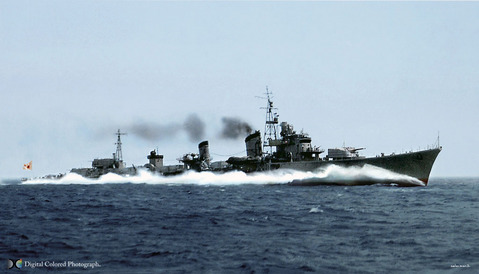The IJN Shimakaze, one-off super-destroyer built for the Imperial Japanese Navy
One of the functions of destroyers in the Pacific (much more prevalent than in any other theater) was the traditional role of launching torpedo attacks. Some of the earliest instances of this duty came in the wake of the Japanese attack on Pearl Harbor. Following the crippling of the U.S. Pacific Fleet as well as the destruction of a British force comprised of a battleship and a battle cruiser, the only Allied forces facing the Japanese were cruisers and destroyers. In late 1941, the United States, Great Britain, the Netherlands, and Australia formed a united command (ABDA Command) for the defense of Southeast Asia. The attempts of this force to disrupt Japanese movements led to several engagements where destroyers were heavily engaged.
The best example of destroyers as torpedo attack vessels is the 27 February 1942 Battle of the Java Sea. Five cruisers and nine destroyers of ABDA Command had sortied with the intention of intercepting a Japanese invasion force bound for Java that included 4 cruisers and 14 destroyers. In the resulting action, both sides launched torpedo attacks. Although the U.S. effort was a failure, that of the Japanese, who had always placed great emphasis on the torpedo and had meticulously trained in the execution of torpedo attacks, was successful. The devastating power of the Japanese Long Lance torpedo, as well as its superior range that allowed for the launch of an attack before Allied warships were able to do the same, exacted a heavy toll. By the end of the engagement, the Allied force had lost two cruisers and four destroyers while the Japanese vessels escaped intact. Gunfire was responsible for a large part of the destruction, but Japanese torpedoes sank one destroyer, damaged another, and were possibly responsible for the sinking of an additional destroyer. This battle decimated ABDA Command and, after one additional engagement, left Southeast Asia devoid of any significant Allied naval presence.
The largest Axis destroyer program was that of Japan, which built conventional destroyers, escort destroyers, and frigates. Destroyers were the only type of warship built in any substantial quantity during the war. Japan launched 33 ships between 1941 and 1945 that were of conventional destroyer designs. The first units produced after the outbreak of war in Europe were the final six Kagero-class vessels. These were followed by Japan’s first wartime construction, the 20 Yugumo-class destroyers that were generally the same as the preceding Japanese destroyers. Indeed, all Japanese destroyer classes save one were largely based on the design specifications of Fubuki. In 1942, Shimakaze was launched as an experimental one-ship class looking forward to the construction of larger destroyers.
The experience gleaned from Shimakaze led to the launch of 12 ships of the Akitsuki class that were designed primarily as fast AA defense escorts for aircraft carriers. These were among the last fleet destroyers built for the Imperial Japanese Navy. The hull of Akitsuki measured 440 feet, 3 inches by 38 feet, 1 inch by 13 feet, 7 inches, displaced 2,701 tons, and possessed turbines that generated a maximum speed of 33 knots. Its armament consisted of eight 3.9-inch guns in dual mounts that were fully enclosed by gun houses. Two each were sited in the bow and stern. These guns, like previous Japanese destroyers, were dual-purpose weapons capable of firing on surface targets and aircraft. The vessel also carried four 24-inch torpedo tubes, four 25mm AA weapons, and 72 depth charges.
Most Japanese destroyers were refitted with additional antiaircraft guns to the extent that one of the gun houses and its armament were removed to allow the necessary space. In some cases, so many AA weapons were carried that the stability of the ship was undermined. Japanese destroyers were also retrofitted with radar sets, but these were inferior to the equipment of the Allies.
In addition to its conventional destroyers, the Japanese mirrored the Allies with the construction of both escort destroyers and frigates. Two classes totaling 32 escort destroyers were constructed during the war. These were more heavily armed than their U.S. and British equivalents but still designed primarily for convoy escort duty. Both types were similarly armed. A unit of the Tachibana class measured 328 feet, 1 inch by 30 feet, 8 inches by 11 feet, 1 inch and displaced 1,289 tons. It mounted three 5-inch guns in single mounts, four 24-inch torpedo tubes, and 60 depth charges. The vessel’s turbines were capable of 27.8 knots.
All of Japan’s escort destroyers were launched between 1944 and 1945 and represent a reaction to the desperate need for commerce protection in the face of a U.S. submarine campaign that had produced staggering losses in merchant shipping by this point in the war. The dearth of escorts was the result of the fact that the Japanese had not planned for a protracted war in which large numbers of escorts were necessary to protect the empire’s commerce. The Japanese escort destroyers were an adequate design, but their small numbers were insufficient to protect against U.S. submarines. Had these been produced earlier and in greater numbers, the outcome of the U.S. submarine campaign, in which Japanese trade was decimated and their war effort crippled, may have been different. The majority of Japan’s 264 frigates were, like the escort destroyers, launched late in the war and consequently did little to reverse the damage already done by U.S. submarines.
